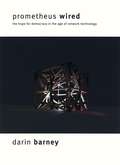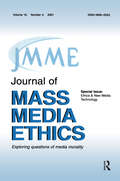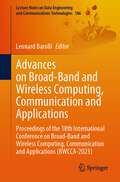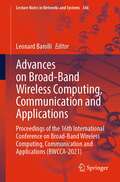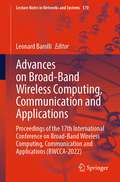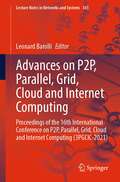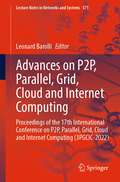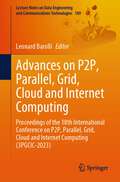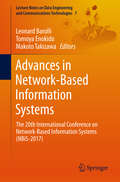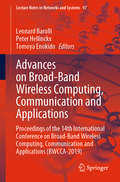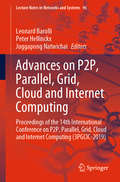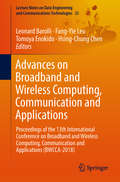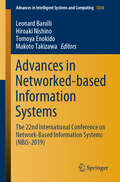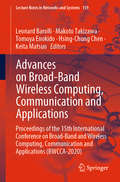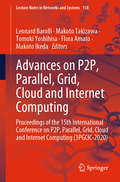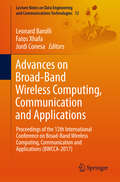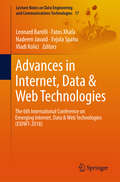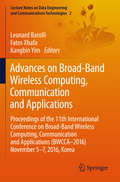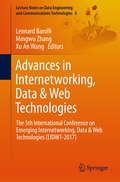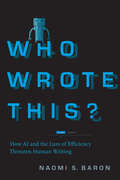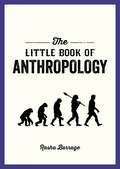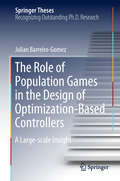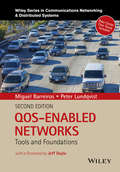- Table View
- List View
Prometheus Wired: The Hope for Democracy in the Age of Network Technology
by Darin BarneyFrom all sides, we hear that computer technology, with its undeniable power to disseminate information and connect individuals, holds enormous potential for a reinvigoration of political life. But will the Internet really spark a democratic revolution? And will the changes it brings be so profound that past political thought will be of little use in helping us to understand them? In Prometheus Wired, Darin Barney debunks claims that a networked society will provide the infrastructure for a political revolution and shows that the resources we need for understanding and making sound judgments about this new technology are surprisingly close at hand. By looking to thinkers who grappled with the relationship of society and technology, such as Plato, Aristotle, Marx, and Heidegger, Barney critically examines such assertions about the character of digital networks. Along the way, Barney offers an eye-opening history of digital networks and then explores a wide range of contemporary issues, such as electronic commerce, telecommuting, privacy, virtual community, digital surveillance, and the possibility of sovereign governance in an age of global networks. Ultimately, Barney argues that instead of placing power back in the hands of the public, a networked economy seems to exacerbate the worst features of industrial capitalism, and, in terms of the surveillance and control it exerts, reduces our political freedom. Of vital interest to politicians, communicators, and anyone concerned about the future of democracy in the digital age, Prometheus Wired adds a provocative new voice to the debate swirling around "the Net" and the ways in which it will, or will not, change our political lives.
Ethics & New Media Technology: A Special Issue of the journal of Mass Media Ethics
by Ralph D. Barney Jay BlackThis special issue shows that "old ethics" don't always provide ready answers to problems raised by new technology. Exploring the perplexing topic of ethics in new media, this special issue: *examines the ethics of the highly controversial 1998 Cincinnati Enquirer exposé of Chiquita Brands International; *reports on a pilot project involving online journalists and online journalism graduate students; *investigates the extent to which e-mail and listservs are--and could be--effective fora for journalists interested in exploring matters of ethics; and *provides a useful annotated webliography of information resources.
Advances on Broad-Band and Wireless Computing, Communication and Applications: Proceedings of the 18th International Conference on Broad-Band and Wireless Computing, Communication and Applications (BWCCA-2023) (Lecture Notes on Data Engineering and Communications Technologies #186)
by Leonard BarolliThe aim of this book is to provide latest research findings, innovative research results, methods, and development techniques from both theoretical and practical perspectives related to the emerging areas of broad-band and wireless computing. Information networks of today are going through a rapid evolution. Different kinds of networks with different characteristics are emerging and they are integrating in heterogeneous networks. For these reasons, there are many interconnection problems which may occur at different levels of the hardware and software design of communicating entities and communication networks. These kinds of networks need to manage an increasing usage demand, provide support for a significant number of services, guarantee their QoS, and optimize the network resources. The success of all-IP networking and wireless technology has changed the ways of living the people around the world. The progress of electronic integration and wireless communications is going to pave the way to offer people the access to the wireless networks on the fly, based on which all electronic devices will be able to exchange the information with each other in ubiquitous way whenever necessary.
Advances on Broad-Band Wireless Computing, Communication and Applications: Proceedings of the 16th International Conference on Broad-Band Wireless Computing, Communication and Applications (BWCCA-2021) (Lecture Notes in Networks and Systems #346)
by Leonard BarolliThis book states that information networks of today are going through a rapid evolution. Different kinds of networks with different characteristics are emerging and they are integrating in heterogeneous networks. For these reasons, there are many interconnection problems which may occur at different levels of the hardware and software design of communicating entities and communication networks. These kinds of networks need to manage an increasing usage demand, provide support for a significant number of services, guarantee their QoS, and optimize the network resources. The success of all-IP networking and wireless technology has changed the ways of living the people around the world. The progress of electronic integration and wireless communications is going to pave the way to offer people the access to the wireless networks on the fly, based on which all electronic devices will be able to exchange the information with each other in ubiquitous way whenever necessary.The aim of the book is to provide latest research findings, innovative research results, methods, and development techniques from both theoretical and practical perspectives related to the emerging areas of broad-band and wireless computing.
Advances on Broad-Band Wireless Computing, Communication and Applications: Proceedings of the 17th International Conference on Broad-Band Wireless Computing, Communication and Applications (BWCCA-2022) (Lecture Notes in Networks and Systems #570)
by Leonard BarolliThis book aims to provide latest research findings, innovative research results, methods, and development techniques from both theoretical and practical perspectives related to the emerging areas of broadband and wireless computing. Information networks of today are going through a rapid evolution. Different kinds of networks with different characteristics are emerging, and they are integrating in heterogeneous networks. For these reasons, there are many interconnection problems which may occur at different levels of the hardware and software design of communicating entities and communication networks. These kinds of networks need to manage an increasing usage demand, provide support for a significant number of services, guarantee their QoS, and optimize the network resources. The success of all-IP networking and wireless technology has changed the ways of living the people around the world. The progress of electronic integration and wireless communications is going to pave the way to offer people the access to the wireless networks on the fly, based on which all electronic devices will be able to exchange the information with each other in ubiquitous way whenever necessary.
Advances on P2P, Parallel, Grid, Cloud and Internet Computing: Proceedings of the 16th International Conference on P2P, Parallel, Grid, Cloud and Internet Computing (3PGCIC-2021) (Lecture Notes in Networks and Systems #343)
by Leonard BarolliThis book provide latest research findings, innovative research results, methods and development techniques from both theoretical and practical perspectives related to P2P, grid, cloud and Internet computing as well as to reveal synergies among such large-scale computing paradigms. P2P, grid, cloud and Internet computing technologies have been very fast established as breakthrough paradigms for solving complex problems by enabling aggregation and sharing of an increasing variety of distributed computational resources at large scale.Grid computing originated as a paradigm for high performance computing, as an alternative to expensive supercomputers through different forms of large-scale distributed computing. P2P computing emerged as a new paradigm after client-server and web-based computing and has shown useful to the development of social networking, Business to Business (B2B), Business to Consumer (B2C), Business to Government (B2G), Business to Employee (B2E) and so on. Cloud computing has been defined as a “computing paradigm where the boundaries of computing are determined by economic rationale rather than technical limits.” Cloud computing has fast become the computing paradigm with applicability and adoption in all application domains and providing utility computing at large scale. Finally, Internet computing is the basis of any large-scale distributed computing paradigms; it has very fast developed into a vast area of flourishing field with enormous impact on today’s information societies serving thus as a universal platform comprising a large variety of computing forms such as grid, P2P, cloud and mobile computing.
Advances on P2P, Parallel, Grid, Cloud and Internet Computing: Proceedings of the 17th International Conference on P2P, Parallel, Grid, Cloud and Internet Computing (3PGCIC-2022) (Lecture Notes in Networks and Systems #571)
by Leonard BarolliThis book aims to provide latest research findings, innovative research results, methods and development techniques from both theoretical and practical perspectives related to P2P, Grid, Cloud and Internet computing as well as to reveal synergies among such large-scale computing paradigms. P2P, Grid, Cloud and Internet computing technologies have been very fast established as breakthrough paradigms for solving complex problems by enabling aggregation and sharing of an increasing variety of distributed computational resources at large scale. Grid Computing originated as a paradigm for high-performance computing, as an alternative to expensive supercomputers through different forms of large-scale distributed computing. P2P Computing emerged as a new paradigm after client–server and web-based computing and has shown useful to the development of social networking, B2B (Business to Business), B2C (Business to Consumer), B2G (Business to Government), B2E (Business to Employee) and so on. Cloud Computing has been defined as a “computing paradigm where the boundaries of computing are determined by economic rationale rather than technical limits.” Cloud computing has fast become the computing paradigm with applicability and adoption in all application domains and providing utility computing at large scale. Finally, Internet Computing is the basis of any large-scale distributed computing paradigms; it has very fast developed into a vast area of flourishing field with enormous impact on today’s information societies serving thus as a universal platform comprising a large variety of computing forms such as Grid, P2P, Cloud and mobile computing.
Advances on P2P, Parallel, Grid, Cloud and Internet Computing: Proceedings of the 18th International Conference on P2P, Parallel, Grid, Cloud and Internet Computing (3PGCIC-2023) (Lecture Notes on Data Engineering and Communications Technologies #189)
by Leonard BarolliP2P, Grid, Cloud, and Internet computing technologies have been very fast established as breakthrough paradigms for solving complex problems by enabling aggregation and sharing of an increasing variety of distributed computational resources at large scale.Grid Computing originated as a paradigm for high performance computing, as an alternative to expensive supercomputers through different forms of large-scale distributed computing. P2P Computing emerged as a new paradigm after client-server and web-based computing and has shown useful to the development of social networking, Business to Business (B2B), Business to Consumer (B2C), Business to Government (B2G), Business to Employee (B2E), and so on. Cloud Computing has been defined as a “computing paradigm where the boundaries of computing are determined by economic rationale rather than technical limits”. Cloud computing has fast become the computing paradigm with applicability and adoption in all application domains and providing utility computing at large scale. Finally, Internet Computing is the basis of any large-scale distributed computing paradigms; it has very fast developed into a vast area of flourishing field with enormous impact on today’s information societies serving thus as a universal platform comprising a large variety of computing forms such as Grid, P2P, Cloud, and Mobile computing. The aim of the book is to provide latest research findings, innovative research results, methods, and development techniques from both theoretical and practical perspectives related to P2P, Grid, Cloud, and Internet Computing as well as to reveal synergies among such large-scale computing paradigms.
Advances in Network-Based Information Systems: The 20th International Conference on Network-Based Information Systems (NBiS-2017) (Lecture Notes on Data Engineering and Communications Technologies #7)
by Leonard Barolli Tomoya Enokido Makoto TakizawaThis book highlights the latest research findings, innovative research results, methods and development techniques from both theoretical and practical perspectives related to the emerging areas of information networking and their applications. It includes the Proceedings of the 20th International Conference on Network-Based Information Systems (NBiS-2017), held on August 24–26, 2017 in Toronto, Canada.Today’s networks and information systems are evolving rapidly. Further, there are dynamic new trends and applications in information networking such as wireless sensor networks, ad hoc networks, peer-to-peer systems, vehicular networks, opportunistic networks, grid and cloud computing, pervasive and ubiquitous computing, multimedia systems, security, multi-agent systems, high-speed networks, and web-based systems. These networks are expected to manage the increasing number of users, provide support for a range of services, guarantee the quality of service (QoS), and optimize their network resources. In turn, these demands are the source of various research issues and challenges that have to be overcome – and which these Proceeding address.
Advances on Broad-Band Wireless Computing, Communication and Applications: Proceedings of the 14th International Conference on Broad-Band Wireless Computing, Communication and Applications (BWCCA-2019) (Lecture Notes on Data Engineering and Communications Technologies #97)
by Leonard Barolli Peter Hellinckx Tomoya EnokidoThis proceedings book presents the latest research findings, innovative research results, methods and development techniques related to the emerging areas of broadband and wireless computing, from both theoretical and practical perspectives. Today’s information networks are going through a rapid evolution. Different kinds of networks with different characteristics are emerging, and are being integrated into heterogeneous networks. As a result, there are numerous interconnection problems that can occur at different levels of the hardware and software design of communicating entities and communication networks. Such networks need to manage an increasing usage demand, provide support for a significant number of services, guarantee their QoS, and optimize the network resources. The success of all-IP networking and wireless technology has changed the way of living for people around the globe. Advances in electronic integration and wireless communications will pave the way to offering access to wireless networks on the fly, which in turn will allow electronic devices to share information with each other wherever and whenever necessary.
Advances on P2P, Parallel, Grid, Cloud and Internet Computing: Proceedings of the 14th International Conference on P2P, Parallel, Grid, Cloud and Internet Computing (3PGCIC-2019) (Lecture Notes on Data Engineering and Communications Technologies #96)
by Leonard Barolli Peter Hellinckx Juggapong NatwichaiThis book presents the latest research findings, innovative research results, methods and development techniques related to P2P, grid, cloud and Internet computing from both theoretical and practical perspectives. It also reveals the synergies among such large-scale computing paradigms. P2P, grid, cloud and Internet computing technologies have rapidly become established as breakthrough paradigms for solving complex problems by enabling aggregation and sharing of an increasing variety of distributed computational resources at large scale.Grid computing originated as a paradigm for high-performance computing, as an alternative to expensive supercomputers through different forms of large-scale distributed computing. P2P computing emerged as a new paradigm after client–server and web-based computing and has proved useful in the development of social networking, B2B (business to business), B2C (business to consumer), B2G (business to government), and B2E (business to employee). Cloud computing has been defined as a “computing paradigm where the boundaries of computing are determined by economic rationale rather than technical limits,” and it has fast become a computing paradigm with applicability and adoption in all application domains and which provides utility computing at a large scale. Lastly, Internet computing is the basis of any large-scale distributed computing paradigms; it has developed into a vast area of flourishing fields with enormous impact on today’s information societies, and serving as a universal platform comprising a large variety of computing forms such as grid, P2P, cloud and mobile computing.
Advances on Broadband and Wireless Computing, Communication and Applications
by Leonard Barolli Fang-Yie Leu Tomoya Enokido Hsing-Chung ChenThis book presents on the latest research findings, and innovative research methods and development techniques related to the emerging areas of broadband and wireless computing from both theoretical and practical perspectives.Information networking is evolving rapidly with various kinds of networks with different characteristics emerging and being integrated into heterogeneous networks. As a result, a number of interconnection problems can occur at different levels of the communicating entities and communication networks’ hardware and software design. These networks need to manage an increasing usage demand, provide support for a significant number of services, guarantee their QoS, and optimize the network resources. The success of all-IP networking and wireless technology has changed the way of life for people around the world, and the advances in electronic integration and wireless communications will pave the way for access to the wireless networks on the fly. This in turn means that all electronic devices will be able to exchange the information with each other in a ubiquitous way whenever necessary.
Advances in Networked-based Information Systems: The 22nd International Conference on Network-Based Information Systems (NBiS-2019) (Advances in Intelligent Systems and Computing #1036)
by Leonard Barolli Hiroaki Nishino Tomoya Enokido Makoto TakizawaThis book focuses on the emerging areas of information networking and its applications, presenting the latest innovative research and development techniques from both theoretical and practical perspectives. Today’s networks and information systems are evolving rapidly, and there are new trends and applications in information networking, such as wireless sensor networks, ad hoc networks, peer-to-peer systems, vehicular networks, opportunistic networks, grid and cloud computing, pervasive and ubiquitous computing, multimedia systems, security, multi-agent systems, high-speed networks, and web-based systems. However, since these networks need to be capable of managing the increasing number of users, provide support for different services, guarantee the QoS, and optimize the network resources, a number of research issues and challenges have to be considered in order to provide solutions.
Advances on Broad-Band Wireless Computing, Communication and Applications: Proceedings of the 15th International Conference on Broad-Band and Wireless Computing, Communication and Applications (BWCCA-2020) (Lecture Notes in Networks and Systems #159)
by Leonard Barolli Makoto Takizawa Tomoya Enokido Hsing-Chung Chen Keita MatsuoThis book aims to provide the latest research findings, innovative research results, methods and development techniques from both theoretical and practical perspectives related to the emerging areas of broadband and wireless computing. Information networks of today are going through a rapid evolution. Different kinds of networks with different characteristics are emerging, and they are integrating in heterogeneous networks. For these reasons, there are many interconnection problems which may occur at different levels of the hardware and software design of communicating entities and communication networks. These kinds of networks need to manage an increasing usage demand, provide support for a significant number of services, guarantee their QoS, and optimize the network resources. The success of all-IP networking and wireless technology has changed the ways of living the people around the world. The progress of electronic integration and wireless communications is going to pave the way to offer people the access to the wireless networks on the fly, based on which all electronic devices will be able to exchange the information with each other in ubiquitous way whenever necessary.
Advances on P2P, Parallel, Grid, Cloud and Internet Computing: Proceedings of the 15th International Conference on P2P, Parallel, Grid, Cloud and Internet Computing (3PGCIC-2020) (Lecture Notes in Networks and Systems #158)
by Leonard Barolli Makoto Takizawa Tomoki Yoshihisa Flora Amato Makoto IkedaThis book aims to provide the latest research findings, innovative research results, methods and development techniques from both theoretical and practical perspectives related to P2P, Grid, Cloud and Internet computing as well as to reveal synergies among such large-scale computing paradigms. P2P, Grid, Cloud and Internet computing technologies have been very fast established as breakthrough paradigms for solving complex problems by enabling aggregation and sharing of an increasing variety of distributed computational resources at large scale. Grid Computing originated as a paradigm for high-performance computing, as an alternative to expensive supercomputers through different forms of large-scale distributed computing. P2P Computing emerged as a new paradigm after client–server and web-based computing and has shown useful to the development of social networking, B2B (Business to Business), B2C (Business to Consumer), B2G (Business to Government), B2E (Business to Employee), and so on. Cloud Computing has been defined as a “computing paradigm where the boundaries of computing are determined by economic rationale rather than technical limits”. Cloud computing has fast become the computing paradigm with applicability and adoption in all application domains and providing utility computing at large scale. Finally, Internet Computing is the basis of any large-scale distributed computing paradigms; it has very fast developed into a vast area of flourishing field with enormous impact on today’s information societies serving thus as a universal platform comprising a large variety of computing forms such as Grid, P2P, Cloud and Mobile computing.
Advances on Broad-Band Wireless Computing, Communication and Applications: Proceedings of the 12th International Conference on Broad-Band Wireless Computing, Communication and Applications (BWCCA-2017) (Lecture Notes on Data Engineering and Communications Technologies #12)
by Leonard Barolli Fatos Xhafa Jordi ConesaThis book gathers the Proceedings of the 12th International Conference on Broad-Band Wireless Computing, Communication and Applications, held on November 8–10, 2017 in Barcelona, Spain. Information networking is currently undergoing a rapid evolution. Different kinds of networks with different characteristics are emerging and being integrated in heterogeneous networks. As a result, there are many interconnected problems that can occur at different levels of the hardware and software design of communicating entities and communication networks. These networks are expected to manage increasing usage demand, provide support for a significant number of services, guarantee Quality of Service (QoS), and optimize the use of network resources.The success of all-IP networking and wireless technology has changed the lifestyles of people around the world, and advances in electronic integration and wireless communications will pave the way to providing access to wireless networks on the fly, as electronic devices can increasingly exchange information with each other virtually anytime and anywhere.The aim of this book is to provide the latest findings, methods and development techniques from both theoretical and practical perspectives regarding the emerging areas of broad-band and wireless computing.
Advances in Internet, Data & Web Technologies: The 6th International Conference on Emerging Internet, Data & Web Technologies (EIDWT-2018) (Lecture Notes on Data Engineering and Communications Technologies #17)
by Leonard Barolli Fatos Xhafa Nadeem Javaid Evjola Spaho Vladi KoliciThis book presents original contributions on the theories and practices of emerging Internet, data and Web technologies and their applicability in businesses, engineering and academia, focusing on advances in the life-cycle exploitation of data generated from the digital ecosystem data technologies that create value, e.g. for businesses, toward a collective intelligence approach.The Internet has become the most proliferative platform for emerging large-scale computing paradigms. Among these, data and web technologies are two of the most prominent paradigms and are found in a variety of forms, such as data centers, cloud computing, mobile cloud, and mobile Web services. These technologies together create a digital ecosystem whose cornerstone is the data cycle, from capturing to processing, analyzing and visualizing. The investigation of various research and development issues in this digital ecosystem are made more pressing by the ever-increasing requirements of real-world applications that are based on storing and processing large amounts of data.The book is a valuable resource for researchers, software developers, practitioners and students interested in the field of data and web technologies.
Advances on Broad-Band Wireless Computing, Communication and Applications: Proceedings of the 11th International Conference On Broad-Band Wireless Computing, Communication and Applications (BWCCA–2016) November 5–7, 2016, Korea (Lecture Notes on Data Engineering and Communications Technologies #2)
by Leonard Barolli Fatos Xhafa Kangbin YimThe success of all-IP networking and wireless technology has changed the ways of living the people around the world. The progress of electronic integration and wireless communications is going to pave the way to offer people the access to the wireless networks on the fly, based on which all electronic devices will be able to exchange the information with each other in ubiquitous way whenever necessary. The aim of the volume is to provide latest research findings, innovative research results, methods and development techniques from both theoretical and practical perspectives related to the emerging areas of broadband and wireless computing. This proceedings volume presents the results of the 11th International Conference on Broad-Band Wireless Computing, Communication And Applications (BWCCA-2016), held November 5-7, 2016, at Soonchunhyang University, Asan, Korea.
Advances in Internetworking, Data & Web Technologies: The 5th International Conference on Emerging Internetworking, Data & Web Technologies (EIDWT-2017) (Lecture Notes on Data Engineering and Communications Technologies #6)
by Leonard Barolli Mingwu Zhang Xu An WangThis book highlights the latest research findings, innovative research results, methods and development techniques, from both theoretical and practical perspectives, in the emerging areas of information networking, data and Web technologies. It gathers papers originally presented at the 5th International Conference on Emerging Internetworking, Data & Web Technologies (EIDWT-2017) held 10–11 June 2017 in Wuhan, China. The conference is dedicated to the dissemination of original contributions that are related to the theories, practices and concepts of emerging internetworking and data technologies – and most importantly, to how they can be applied in business and academia to achieve a collective intelligence approach.Information networking, data and Web technologies are currently undergoing a rapid evolution. As a result, they are now expected to manage increasing usage demand, provide support for a significant number of services, consistently deliver Quality of Service (QoS), and optimize network resources. Highlighting these aspects, the book discusses methods and practices that combine various internetworking and emerging data technologies to capture, integrate, analyze, mine, annotate, and visualize data, and make it available for various users and applications.
Who Wrote This?: How AI and the Lure of Efficiency Threaten Human Writing
by Naomi S. BaronWould you read this book if a computer wrote it? Would you even know? And why would it matter? Today's eerily impressive artificial intelligence writing tools present us with a crucial challenge: As writers, do we unthinkingly adopt AI's time-saving advantages or do we stop to weigh what we gain and lose when heeding its siren call? To understand how AI is redefining what it means to write and think, linguist and educator Naomi S. Baron leads us on a journey connecting the dots between human literacy and today's technology. From nineteenth-century lessons in composition, to mathematician Alan Turing's work creating a machine for deciphering war-time messages, to contemporary engines like ChatGPT, Baron gives readers a spirited overview of the emergence of both literacy and AI, and a glimpse of their possible future. As the technology becomes increasingly sophisticated and fluent, it's tempting to take the easy way out and let AI do the work for us. Baron cautions that such efficiency isn't always in our interest. As AI plies us with suggestions or full-blown text, we risk losing not just our technical skills but the power of writing as a springboard for personal reflection and unique expression. Funny, informed, and conversational, Who Wrote This? urges us as individuals and as communities to make conscious choices about the extent to which we collaborate with AI. The technology is here to stay. Baron shows us how to work with AI and how to spot where it risks diminishing the valuable cognitive and social benefits of being literate.
Who Wrote This?: How AI and the Lure of Efficiency Threaten Human Writing
by Naomi S. BaronWould you read this book if a computer wrote it? Would you even know? And why would it matter? Today's eerily impressive artificial intelligence writing tools present us with a crucial challenge: As writers, do we unthinkingly adopt AI's time-saving advantages or do we stop to weigh what we gain and lose when heeding its siren call? To understand how AI is redefining what it means to write and think, linguist and educator Naomi S. Baron leads us on a journey connecting the dots between human literacy and today's technology. From nineteenth-century lessons in composition, to mathematician Alan Turing's work creating a machine for deciphering war-time messages, to contemporary engines like ChatGPT, Baron gives readers a spirited overview of the emergence of both literacy and AI, and a glimpse of their possible future. As the technology becomes increasingly sophisticated and fluent, it's tempting to take the easy way out and let AI do the work for us. Baron cautions that such efficiency isn't always in our interest. As AI plies us with suggestions or full-blown text, we risk losing not just our technical skills but the power of writing as a springboard for personal reflection and unique expression. Funny, informed, and conversational, Who Wrote This? urges us as individuals and as communities to make conscious choices about the extent to which we collaborate with AI. The technology is here to stay. Baron shows us how to work with AI and how to spot where it risks diminishing the valuable cognitive and social benefits of being literate.
Critical and Historical Essays -- Volume 1
by Baron Thomas Babington Macaulay MacaulayCritical and Historical Essays: Contributed to the Edinburgh Review (1843) is a collection of articles by Thomas Babington Macaulay, later Lord Macaulay. They have been acclaimed for their readability, but criticized for their inflexible attachment to the attitudes of the Whig school of history.
The Little Book of Anthropology: A Pocket Guide to the Study of What Makes Us Human
by Rasha BarrageIf you’re intrigued by the question “What makes us human?”, strap in for this whirlwind tour of the highlights of anthropologyFrom the first steps of our prehistoric ancestors, to the development of complex languages, to the intricacies of religions and cultures across the world, diverse factors have shaped the human species as we know it. Anthropology strives to untangle this fascinating web of history to work out who we were in the past, what that means for human beings today and who we might be tomorrow.This pocket-sized introduction includes accessible primers on:Influential anthropologists such as Franz Boas, Margaret Mead and Ruth BenedictThe key branches of anthropology, from physical and linguistic anthropology to archaeologyHow anthropologists study topics such as communication, identity, sex and gender, religion and cultureHow we can approach one of life’s most enduring questions: what is it that truly makes us human?This illuminating little book will introduce you to the key thinkers, themes and theories you need to know to understand the development of human beings, and how our history has informed the way we live today. A perfect gift for anyone taking their first steps into the world of anthropology, as well as for those who want to brush up their knowledge.
The Role of Population Games in the Design of Optimization-Based Controllers: A Large-scale Insight (Springer Theses)
by Julian Barreiro-GomezThis book reports on the implementation of evolutionary-game theory in the design of distributed optimization-based controllers. First, it discusses how the classical population-game approach can contribute to and complement the design of optimization-based controllers. It shows how the features of this approach can be exploited to extend their capabilities in the solution of distributed optimization problems, and examines density games in order to consider multiple coupled constraints and preserve the non-centralized information requirements. Furthermore, it establishes a close relationship between the possible interactions among agents in a population with constrained information sharing among different local controllers. It also discusses coalitional games, focusing on the Shapley power index and proposes an alternative method of computing the latter, which reduces computational time, as well as a different way of finding it using distributed communication structures. All the proposed strategies are then tested on various control problems, such as those related to the Barcelona water supply network, multiple continuous stirred tank reactors, various unmanned aerial vehicle systems, and a water distribution system. This thesis, examined at the Universitat Politècnica de Catalunya and Universidad de los Andes in 2017, received the award for best thesis in control from the control group of the Spanish Committee of Automatic Control (CEA) in the same year.
QOS-Enabled Networks: Tools and Foundations (Wiley Series on Communications Networking & Distributed Systems #42)
by Miguel Barreiros Peter LundqvistWritten by two experts in the field who deal with QOS predicaments every day and now in this 2nd edition give special attention to the realm of Data Centers, QoS Enabled Networks:Tools and Foundations, 2nd Edition provides a lucid understanding of modern QOS theory mechanisms in packet networks and how to apply them in practice. This book is focuses on the tools and foundations of QoS providing the knowledge to understand what benefits QOS offers and what can be built on top of it.
